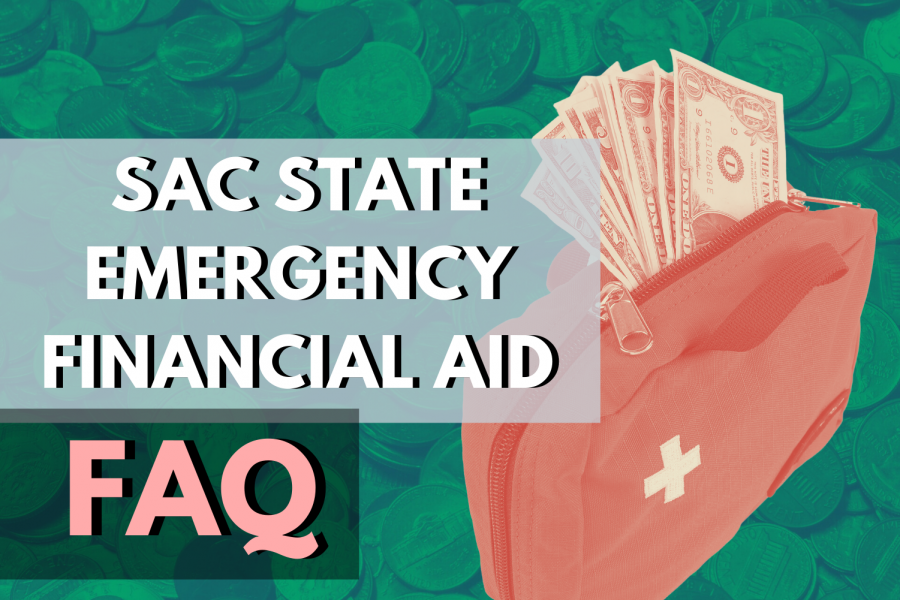FAQ: What you need to know about Sac State’s emergency financial aid grants
Who qualifies for HEERF emergency grants, how to get it and more
Sacramento State President Robert Nelsen announced emergency financial aid grants from the CARES Act will be disbursed to any student eligible for FAFSA at a virtual faculty town hall Monday, April 27. Graphic made in Canva.
April 28, 2020
Emergency financial aid grants will be disbursed to all Title IV eligible students after Sacramento State received over $35 million in emergency federal stimulus funds, university President Robert Nelsen said during a faculty town hall meeting Monday.
Title IV is the portion of the Higher Education Act that authorizes financial aid to higher education institutions.
The money comes from the Higher Education Emergency Relief Fund (HEERF), which is part of the Coronavirus Aid, Relief and Economic Security (CARES) Act signed into law March 27.
RELATED: Sac State virtual town hall addresses CARES Act, budget, fall semester
The State Hornet put together a FAQ to help answer questions from students about the emergency financial aid grants.
Question: What are the HEERF emergency grants?
Answer: The HEERF emergency grants are funds that will be disbursed to students as relief for expenses related to the disruption of campus operations caused by the coronavirus pandemic, Nelsen said in a SacSend email sent Thursday. This includes expenses for food, housing, course materials, healthcare and childcare.
Q: Do you need to apply to receive a grant?
A: No, students do not need to apply for an emergency financial aid grant. Funds will be disbursed automatically to qualifying students through eRefund or by mail, Nelsen said. Students are encouraged to update their address in their My Sac State student center or set up direct deposit through eRefund.
Q: Who qualifies for a grant?
A: Any student who qualifies as Title IV eligible, are currently enrolled in a degree-seeking program for spring 2020 and were not enrolled in a completely online program as of March 13 will receive a HEERF Emergency Grant, according to Nelsen.
Postgraduate students, including doctorate and masters’ students, are included. Undocumented students will also receive a grant; however, the U.S. Department of Education excludes international students from eligibility, Nelsen said.
Q: Who qualifies as Title IV eligible?
A: Any student who is eligible to fill out a free application for Federal Student Aid (FAFSA) form and are eligible for federal financial aid are Title IV eligible students. Federal financial aid funds including the Pell grant, Supplemental Educational Opportunity Grant and Federal Direct Loans fall under Title IV according to the U.S. Department of Education.
Q: Do I need to apply for FAFSA to receive a grant?
A (UPDATED): No, students do not need to apply for FAFSA or receive aid to qualify. All students who were eligible to apply for FAFSA for spring 2020 and are eligible to receive federal student aid will receive grants.
Q: Are graduating seniors who did not apply for FAFSA for 2020-2021 included?
A (UPDATED): Yes, graduating seniors are included, according to Brian Blomster, Sac State director of news and communications. Any student enrolled in a degree-seeking program for the spring 2020 semester is included in the grants.
Q: When will grants be disbursed?
A (UPDATED): Disbursements are expected to begin the week of May 4, according to an FAQ on student affairs’ website.
Q: How much will students receive?
A (UPDATED): Students determined to be of the highest financial need through FAFSA will receive the highest grant amounts.
Students who are of the highest financial need who are eligible for the Federal Pell Grant will receive $850 for full-time enrollment (12 units or more for undergraduates; 8 units or more for graduates) and $425 for less than full-time enrollment. 16,470 students were determined to be of the highest financial aid, according to Student Affairs’ website.
Students who are eligible for financial aid but are not eligible for the Pell Grant will receive $400 for full-time enrollment and $200 for less than full-time enrollment. This represents 7,434 students.
Students who did not file through FAFSA but were eligible will receive $200 for full-time enrollment and $100 for less than full-time enrollment. 5,009 students fall into this category.
Q: Where does the money come from?
A (UPDATED): Sac State received over $35 million in emergency stimulus funds through the HEERF, which is part of the CARES Act. Schools are required to award at least half of their total allocation to students. Sac State has over $17.8 million to disburse to students in emergency financial aid grants.
Q: What is the CARES Act?
A: The CARES Act is a federal economic relief package signed into law by U.S. President Donald Trump on March 27 to provide economic assistance throughout the country during the coronavirus pandemic. The law appropriates about $14 billion for higher education, with about $12.5 billion to be split between emergency grants to students and money for schools’ needs amid the coronavirus pandemic.
Q: Can the school use the money to pay for outstanding student fees?
A: No, Sac State cannot use the funds for emergency financial aid grants to pay off a student’s outstanding balance or fees, according to the CARES Act. It also cannot be used for athletics, religious purposes or scholarships.
Q: Is this the same as the Student Emergency Grant (SEG)?
A: No, the emergency financial aid grants from the CARES Act are not the same as the Robert Seth Nelsen Student Emergency Grant (SEG) offered by Sac State. This emergency grant is a separate grant administered by The Office of Student Affairs that assists students experiencing a short-term financial crisis due to unexpected expenses. It is funded from fundraising by students through the Student Advancement Council and the Student Alumni Association.
Students must apply to receive this grant through the Crisis Assistance & Resource Education Support (CARES) office of Student Affairs and meet the necessary requirements. Students can be awarded one SEG each academic year.
Q: What if I am in a crisis and need more aid?
A: Sac State has set aside $1.6 million from the HEERF funds to go to students in a crisis as supplemental funds, Nelsen said. Students will have to apply for the supplemental funds, be eligible to receive federal financial aid and be currently enrolled in spring 2020.
Applications will begin to be reviewed the week of May 11. More information on how to apply for the supplemental funds will be shared soon, Nelsen said.
Q: What if I don’t qualify for an emergency financial aid grant?
A: Sac State has set up a different fund for students who don’t qualify for federal financial aid or the emergency financial aid grants, Nelsen said. The fund will include those who file for the California Dream Act, international students and students who were enrolled in completely online programs prior to March 13.
More information on how to apply for the funds will be shared soon, Nelsen said.
UPDATE: Thursday, April 30, 2020
This article was updated to reflect new information from Sac State released Thursday, including how much money students will receive, when the money will be disbursed, and confirmation that graduating seniors qualify to receive the grants.





































































































































Carrie Ann Halcovich • Apr 30, 2020 at 4:24 pm
I was not enrolled for spring 2020. I applied for financial aide last year and again this year, so I have my application on file. I am enrolled in summer 2020. Silly question, do I qualify for any of the money in this article?
Thanks
Chris Savage • Apr 30, 2020 at 12:21 pm
Thank you very much for this information. A blessing in these times
Selenne Martinez • Apr 29, 2020 at 4:46 pm
Honestly, upon finding this article I felt serious stress lift from my body! I have been so anxious about money, I fully support myself while taking 5 full classes. I had a great opportunity lined up for me and I felt like the first time since I began at Sac State, I was going to be financially comfortable. COVID ripped that sense of security from me but this article has given me a little flicker of comfort again.
Very grateful for this!